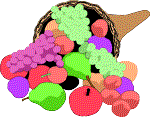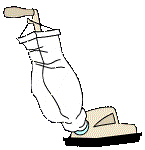Classroom Animals and Pets - Insects and
Co.- Walking Sticks
 Walking Sticks
- Definition
Walking Sticks
- Definition
The World Book Encyclopaedia definition for Walking Sticks
is:
1. a stick used in walking; a cane.
2. any one of a group of mostly wingless insects related to the
grasshoppers, having a body like a stick or twig; stick insect.
 Back to top
Back to top
 Comments
Comments
NOTE: Walking stick insects are not permitted in all areas!
Please check your local and state/provincial regulations, especially in the
United States. (Be aware that seeing walking sticks for sale in some of your local
petstores does NOT guarantee that they are legal pets!) In warm climates, they
have the potential to become serious pests. If you are permitted to keep them,
by virtue of being educators in your area, please do not give away live walking
sticks or walking stick eggs to your students! Walking sticks lay hundreds of
eggs! Each time you clean out the bramble or substrate material, you have to be
SURE that you are not throwing out eggs too! Personally, I collect all waste material
from my tanks and freeze it for two weeks before discarding. (Yes... my family
is aware that the big black bags in our deep freezer do NOT hold anything they
want to know about!)
My introduction to Walking Sticks came about as part of a new
Grade 2 unit that our school was doing on “Creeping Crawlies”.
One of my students excitedly brought in a plastic terrarium with
a dozen or so Indian Walking Stick insects obtained from a local
college. The instructions were to feed them lettuce and to occasionally
spray them lightly. Another note was to keep the soil substrate
lightly humidified after the sticks had all died. Supposedly I
would be rewarded with a “new crop” of insects. The
class and I were all most intrigued with these marvelously camouflaged
insects, especially with their ability to fold up their legs and
REALLY look like sticks or twigs! Then one day a student called
out in horror that some of the sticks appeared to be bleeding
around the “armpits”. What a relief it was to find that
this reddening seemed to be, instead of a sign of injury, a sign
of “adulthood”! Doing a little reading on these insects
(and there was NOT much reading to be found!), I also relearned
the term “parthenogenic” - wherein the female of the
species lays eggs which are clones of herself. We learned that
males were exceedingly rare in this species and that you had to
“have one” to “get one” ! Within the school
year all our adults did eventually die off. Within a few weeks,
however, we were very excited to find that the soil did “magically”
produce a whole new group of youngsters, and so the learning began
again. Getting “the bug” for “ bugs” did not
stop there, however. I set out one day on the trail of a lutino
cockatiel hen at a yard sale (my husband and I are hobby breeders)
and ended up coming home with NO cockatiel but instead a small
container of species of another walking stick... the Annam Stick
from Vietnam.
In the summer following it so happened that three very strange,
and large, stick insects appeared in my local pet shop. These
were labeled as Giant Prickly Sticks and were priced at a whopping
$19.95 each. No way I would pay $20 for a BUG I thought, but I
kept coming back to watch these fascinating creatures. They WERE
marvelous and they were BIG and ... well... I did do a lot of
spending in this particular pet shop so they decided to take me
up on a trade... 30 of my walking sticks for one of the Giant
Pricklies! Naturally, I “bought” both of the remaining
Pricklies. This truly was the beginning of my fascination with
Walking Stick insects. The following year I scoured the bookstores
looking for information. There didn’t seem to be much out
there, until I hit upon Gordon Ramel’s website for the Phasmid
Study Group in England. Wow, there were LOTS of different walking
sticks and LOTS of people who were interested in them! In this
first year I had the energy to have my class count and graph the
eggs coming from these two female Pricklies... but I had to keep
revamping the graphing format because to my surprise we got to
over 900 eggs by June! (Thank goodness I learned how to properly
dispose of most of them!) At that time I had no idea there were
any male Pricklies out and about... I just assumed they were like
my Indian Sticks. A year passed and the next summer I was hot
on the trail of a Preying Mantis when... lo and behold... I found
my first male Prickly. Now I was hooked! I paid $15 cash
(for a BUG!!!) and then went back to buy a second one! (Oh dear!)
My husband just had to shake his head and say “more bugs???”
 Back to top
Back to top
 Housing
Housing
Your container needs a very snug cover that provides ventilation,
but does not allow the very tiny babies to escape. There must
be at least 2 1/2 times the length of the adult in height, so
that proper skin shedding can occur. Also, overcrowded conditions
are just as bad for these insects as for any other animal. While
I have not witnessed any aggressive behaviours in the species
I have kept, overcrowding is very harmful to proper skin shedding.
In a ten gallon tank you could keep ten to twenty Indian sticks,
about ten Annam sticks, or three or four Giant Prickly sticks.
If you are mixing species, then you will have to judge what seems
appropriate.
The substrate might be soil, newspaper, or “nothing”. I found that
a corn cob substrate (which I admired in a pet store) tended to get moldy with
a daily misting. Soil gives a more “natural” appearance in my opinion,
and so at school I provide a soil base. At home I generally use layers of newspaper.
My stick insects are kept out of direct sunlight. The ones
at school have overtop fluorescent lights and the ones at home
do not. Both receive indirect light from outside. I have not seen
any significant differences in the walking sticks themselves,
but I do find that the bramble in the ones at school dries out
much faster.
Of the three insects mentioned, the Indian stick is the only
one I have witnessed near a water dish. We do spray our tanks
daily, however, (except for weekends).
I use both plastic and glass tanks. I also use both homemade
and commercial lids. The plastic terrariums with snap-on lids
are very good - but I always use a sheet of hardware cloth under
the lid. Walking stick babies could easily slip out of the slots
in the plastic terrariums. It also is much easier to clean a tank
with an extra sheet of meshing on top. I have made several wood
frame lids with aluminum hardware cloths. These are so very much
cheaper than the purchased metal frames, but I must warn you that
if you are not much of a carpenter (and I’m not!), then you
will spend a lot of time to produce an not-very-elegant lid. Find
a carpenter friend if you can! Be sure to use the finest size
of mesh screening too!
At school I now have two lovely 30+ gallon tanks, with mixed
collections in each. At home I prefer to keep each species separate
in 5 to 15 gallon tanks. I use plastic cups for the eggs and plastic
tanks for when the babies start hatching. As the babies grow,
I transfer them into their larger “adult” glass tanks.
(Note: I do try to set a maximum of adults kept and have periodic
“cullings out” where I humanely (according to the experts)
dispose of extras).
I do not supply any extra heating, however, all of my sticks
remain at a comfortable room temperature throughout the year.
 Back to top
Back to top
 Food
Food
Stick insects seem marvelously adapted to eating bramble (blackberry
bushes). This in itself is a very good reason why you should be
very careful not to inadvertently release any into the wild! Here
in the Vancouver area we have bramble available throughout the
year (although the pickings are pretty lean in February!) and
I use it exclusively with my sticks. Other food sources which
can be tried are ivy, privet, oak, rose, hawthorn, pyracantha,
strawberry leaves or beetroot leaves. In areas having more severe
winters, however, there may be a significant problem in providing
food over the winter. If eggs have been laid already, one might
argue that the death of adults due to insufficient food is simply
a “part of nature”. Not a pleasant thought for the pet-keeper,
however! Some species, such as the Indians, will also eat commercial
lettuce. Mountain laurel is another leaf which is sometimes accepted.
I have tried many variations on holders for the bramble which
my sticks eat. I now use the cut-off bottom half of a plastic
2 litre pop bottle filled with gravel. If I am only needing a
small container, I might use a plastic cup with attached lid or
one of those single-flower plastic stem vials. The latter are
particularly handy when using one leaf as opposed to a branch
with several leaves. When I replenish my leaves, I fill container
half full with gravel and then stick in the bramble. I then ‘top
off’ the container with gravel and add water. This assures
that the stems are well sunk in the container without breaking
the stems (or poking my fingers too much!).
Water is needed in differing amounts. Some species of walking
sticks will actually drink from a bowl, some need a constant high
humidity, whereas others seem to get by on the moisture obtained
from leaves. I spray all of my stick tanks daily. I provide a
pot of water (with a large sponge in it) when I go away for more
than a weekend.
 Back to top
Back to top
 Maintenance
Maintenance
In order to see your insects properly, the glass sides should be wiped clean
with a damp cloth about once a week. At school I generally leave the soil substrate
for a couple of weeks, unless I am doing a weekly egg count. (If I were using
newspaper, I would do it weekly.) As soon as I notice young babies in a tank,
however, I must immediately decide what to do or there will be a LOT of time
added to the weekly changing over of leaves. It is a big job to check each and
every leaf for youngsters! Sometimes I transfer the soil into a “baby container”
and sometimes I destroy any future potential eggs by freezing for two or more
weeks. I use Ziploc freezer bags for the soil and/or eggs. Indian and Annam
species take about 2 months to hatch whereas the larger Prickly eggs take about
8 to 9 months. At home I generally let a good number of babies hatch (for my
next generation) and then destroy any and all further eggs until the following
year.
It is an easy job at home to clean the bottom of the tank weekly, because I
have layers of newspaper and simply remove the top layer each week. Every month
or so, I remove everything and simply sweep up the floor with a mini “dolly
broom and dustpan” and wipe with a damp cloth. It is much easier to find
eggs with this method, as opposed to using soil as a substrate.
The biggest weekly job is changing over the bramble leaves.
For my own scheduling purposes, I try to adjust the amount of
leaves I collect so that I will be changing over the leaves on
the same day each week. I feel rather clumsy in gardening gloves,
so I always seem to get several thorn slivers by the end of each
cleanup session. That is an uncomfortable drawback!
 Back to top
Back to top
 General Information
General Information
Insects have been around for some 325 million years! Walking
Sticks are properly known as Phasmatodea (Order = Phasmida), “phasma”
meaning “ghost” and referring to the excellent way they
seem to disappear into the foliage. They can remain nearly motionless
for hours on end during the day, or alternatively adopt a swaying
motion, imitating a twig in a breeze. They often are very good
at feigning death when attacked, dropping to the ground and becoming
virtually invisible. They generally are more active feeders at
night. They are usually green or brown and often have the body
shape of a thin twig or branch. Some have wings and others have
more elaborate markings or growths which help them blend into
their surroundings. A few also have chemical secretions for defense.
They appear almost all around the world, with the most numbers
of species predominating in warmer climates. They range in size
from only a few centimeters (1/2 inch) to surprising sizes of
20 cm. (8 inches), with the very largest being 33 cm. (13 inches).
There are over 2500 different species of walking sticks, although
only a few are readily available as pets. Most of them readily
eat bramble (blackberry) leaves.
 Back to top
Back to top
 Characteristics-
General
Characteristics-
General
• As insects they have a three part body (head, thorax,
abdomen) with six legs.
• They do not have an internal skeleton, but have a tough
outer skin known as the cuticle.
• Breathing is accomplished through about 20 small openings
called spiracles, which can be found down the side of the body.
Air passes through tubes into the body tissues.
• The antennae are covered with minute hairs which can detect
changes, such as in temperature, body position, and chemical “smells”.
These hairs are present, in fewer numbers, over the rest of the
body as well.
• They have two compound eyes which enable them to see clearly
and in colour.
• Some stick insects also have three simple eyes on top of
the head which register light only.
• They have two claws and four suction pads on their feet.
This enables them to climb a variety of surfaces, including glass.
• Stick insects do not eat continuously, but take “meals”
during the day and night.
• They produce only “uric acid” as a waste material,
with the droppings being fairly dry and odourless.
• Stick insects lay eggs. The eggs may take anywhere from
one to nine months to hatch, depending on the species. Some eggs
are dropped, some buried, some “glued” to surfaces.
• The babies are called nymphs and look very similar to the
adults. They are not exactly the same, however, and so the process
is called Incomplete Metamorphosis. Winged adults, for example,
do not obtain their wings until the final moult.
• The nymphs grow by climbing out of their skins, while hanging
upside down. This moulting is called Ecdysis and may occur five
or six times. The stages are called Instars.
• Regeneration of limbs with successive moults is often possible,
if the insect is quite young. Antennae do not regenerate, however.
• After the final moult, reproduction is possible. some species
can reproduce by parthenogenesis. The female alone lays eggs which
are exact duplicates of herself. Other species reproduce sexually,
with the male transferring a spermatophore (a little bag of sperm)
to the tip of the female’s abdomen. In some species, such
as the Giant Prickly, the spermatophore is readily visible.
• The eggs of the different species differ in size, shape,
and colour but all resemble little “seeds”. They have
a special lid or “plug” know as an operculum, which
the nymph pushes off and then climbs out the hole. Newly hatched
nymphs can often be seen with the egg still attached to the final
leg to emerge.
• Walking Sticks generally live about 1 year. Males often
do not live as long as females.
 Back to top
Back to top
Characteristics- Indian Walking Stick or
Common Laboratory Stick
• Carausius morosus, Phasmid Study Group PSG#1
• origin: India
• specimens available are generally parthenogenic (all females)
• grows up to 10cm., the ones I have seen did not exceed
8 cm.
• no wings
• foods: Privet, Ivy, Hawthorn, Pyracantha, Bramble, Rose
• Indian sticks are usually a green or brownish green. They
are a wonderful example of “stick behaviour” because
they readily fold up their legs and drop to the ground looking
exactly like a bit of twig. They will lie seemingly “dead”
in your hand for a very long time. On branches they often lie
right against the branches and are virtually invisible. They also
will suspend between two branches, with a deceiving “crook”
or bend in their bodies!
• They can also be handled (gently!) and do not bite, sting,
or do anything unpleasant! If you let them gently walk onto your
hand, then they are not so quick to “fold up”.
• They are very easy to raise, and are accepting of many
food sources, including garden lettuce. This highlights the need
to be extremely careful when disposing of leaves and eggs. Put
all dead branches in a freezer for a week before disposing, especially
when there are nymphs involved. (I simply pack them in a large
black garbage bag and pop into the deep freeze.) All substrates
should be likewise carefully treated. (I pack my bottom soil in
a Ziplock bag and “zap” in the microwave for one minute
to assure there are no viable eggs left.)
 Back to top
Back to top
Characteristics- Annam Walking Stick
• Baculum extradentatum, Phasmid Study Group PSG#5
• origin: Vietnam
• specimens available are generally parthenogenic (all females)
• grows up to 10cm.
• no wings
• foods: Bramble, Hawthorn, Oak, Rose
• Annam sticks are usually a brownish colour. The body is
very similar to the twig like appearance of the Indian sticks,
but they do not fold up their legs when disturbed. This gives
them a more “spider-like” appearance, in my opinion.
• They seem to be a little larger than the Indian sticks
I have obtained.
• They can also be handled (gently!) and do not bite, sting,
or do anything unpleasant! They quite readily walk on your hand/arm.
 Back to top
Back to top
Characteristics- Giant Prickly Stick or
Macleays Spectre
• Extatosoma tiaratum, Phasmid Study Group PSG#9
• origin: Queensland, Australia
• specimens can be parthenogenic (all females) if no males
are available!
• grows up to 15cm.
• the female has tiny vestigial wings, the male has functional
wings
• food: Bramble, Eucalyptus*, Hawthorn, Oak, Rose
*(note: this is not the ornamental Eucalyptus!)
• the male and female are distinctly different. Males have
thin, smooth, straight bodies and long wings. The females have
thick bodies with lots of “prickles”. Their heads are
larger than the males and they can roll their bodies up in a scorpion-like
pose. Differences are clearly apparent by the third instar. The
males have a noticeably smoother body than the females.
• females exhibit a lot of the “swaying in the breeze”
motion.
• Giant Pricklies can also be handled (gently!) and do not
bite or sting. Be careful not to catch your skin in between their
legs or it will pinch when they bend their legs. They quite readily
walk on your hand/arm. Females “wave” their front legs
“at you”. It is probably a defense, but it looks like
they are reaching for you!
• A note on the youngsters: they are very fast... more so
than most of the other species I have seen! They are also a different
colour from the adults. After hatching, and before the first molting,
the nymphs are black with red heads. This has been suggested to
be “ant mimicry”. See the Gordon Ramel websites for
more information on this. Evidently the capsula in the egg is
supposed to contain substances attractive to ants. The ants will
pull off the capsula, aiding in hatching.
 Back to top
Back to top
Teaching Ideas
• Study the basic anatomy of the walking stick. Look for
the three part body (head, thorax, abdomen). How does the body
shape resemble a stick? Is the head camouflaged?
• Study the six legs for shape and movement. Note where the
legs are attached What order do the legs move in?
• Study the mouthparts when eating.
• Study the body and the body movements for effective camouflage...
does it imitate a twig in a breeze, does it fold up when disturbed?
How long do these movements (or lack of movement!) last? As per
David Kramer in his book Animals in the Classroom, look for one
of the three types of camouflage: protective resemblance, protective
coloration, or protective behaviour.
• Try varying the light source. Is there more movement with
or without an extra light source?
• Food preferences: can you find leaves that your walking
sticks prefers over bramble leaves?
 Back to top
Back to top
Resources
Alderton, David, A Step-by-Step Book About Stick Insects,
USA: T.F.H. Publications, Inc., 1992
Floyd, Dorothy, Keeping Stick Insects, Notts. England:
Floyd Publishing, 1987
Kneidel, Sally, Pet Bugs: A Kid’s Guide to Catching
& Keeping Touchable Insects, USA: John Wiley and Sons,
Inc., 1994, pages 6-9.
Kramer, David C., Animals in the Classroom, USA: Addison-Wesley
Publishing Co., Inc., 1989.
 Back to top
Back to top
Related Web Sites
The Phasmid Study Group: “THE” authorities on Phasmid
care!
http://www.stickinsect.com
-recommended by the Phasmid Study Group
http://www.kis.ch/xedric
Gordon Ramel's excellent site on insect keeping.
http://www.insect-world.com/
Eggs and Classification: The Phasmid connection by John t.
Clark Sellick
A very interesting article devoted to Phasmid eggs.
http://www.linnean.org.uk/lnews/ART1.HTM
Iona and Leigh's Home Page
These two zoologists have some fantastic photos and basic info,
all nicely organized in "PSG" order!
http://www.irms.freeserve.co.uk/index.html
Mad Martian Stick Bug Page!
Lots of pictures here from an obvious enthusiast! Even some music
if you are patient!
http://www.madmartian.com/bug.htm
Mark Watson’s Stick Insect Page
A wonderful site full of pictures, information, and that “personal”
touch!
http://members.aol.com/fluffymark/home.htm
Page from the Sydney Morning Herald Oct. 1997 on the merits
of a stick insect pet!
http://www.smh.com.au/daily/content/971002/national/national12.html
Phasmatodea
A rather technical look at these insects
http://phylogeny.arizona.edu/tree/eukaryotes/animals/arthropoda/hexapoda/phasmatodea/phasmatodea.html#TOC2
Phasmatodea
A nice collection of basic facts, plus a walking stick stamp from
Barbados
http://www.cals.ncsu.edu/ncsu/cals/course/ent425/compendium/stick.html#life
Tony and Charlotte’s Stick Insect Page
Interesting to see how “stick hobbyists” obviously enjoy
their hobby!
http://www.woodcock-bates.demon.co.uk/stick.htm
 Back to top
Back to top
 Back
to Insect and Co. TOC
This page revised April 2002.
Back
to Insect and Co. TOC
This page revised April 2002.

 Comments
Comments Maintenance
Maintenance Characteristics-
General
Characteristics-
General